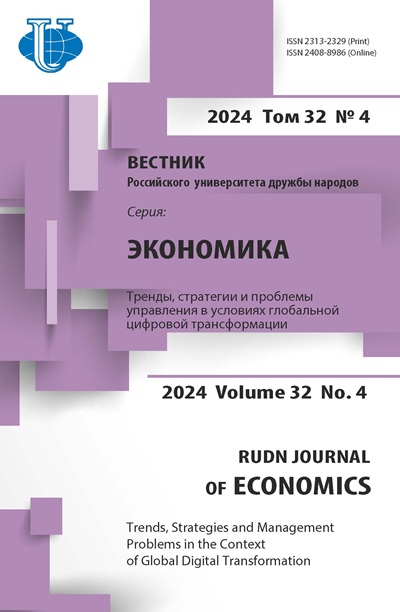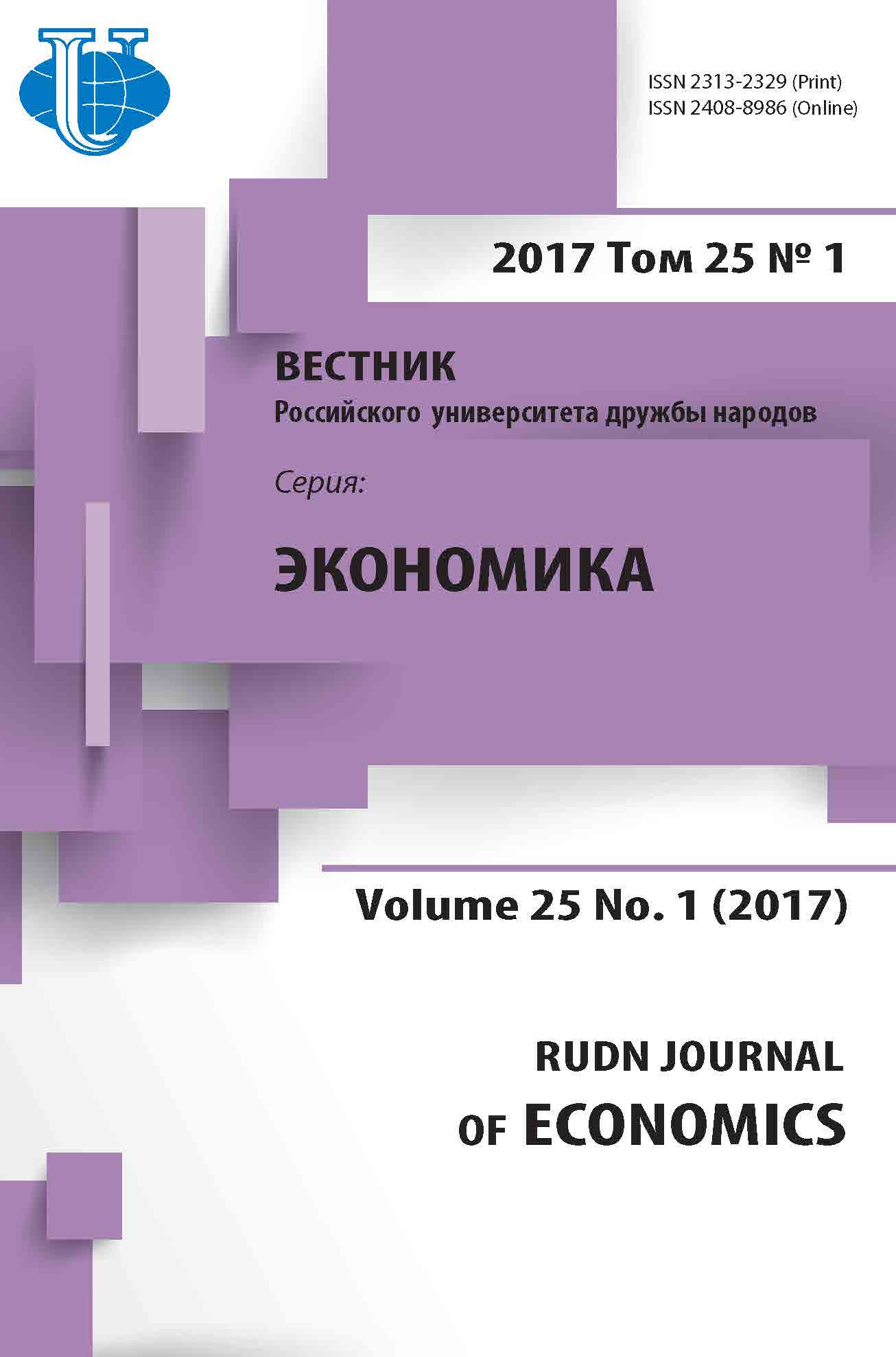Vol 25, No 1 (2017)
- Year: 2017
- Articles: 12
- URL: https://journals.rudn.ru/economics/issue/view/1020
- DOI: https://doi.org/10.22363/2313-2329-2017-25-1
Full Issue
Articles
The Contemporary Approaches to Interpretation of the Sustainable Development Concept
Abstract
In this article, the author analyzes the current approaches to interpretation of such a modern scientific phenomenon as the sustainable development concept. Actually, the inception of new attitudes to it derives from the fact that there is no generally accepted meaning of the term. The author emphasizes that the concept interpretation depends much on the changing global context, so every scientific approach tackles the tasks of the particular historic period. The paper elaborates and deepens the current research, clarifies the definitions and conceptual framework of sustainable development, determines its topical interpretations that correspond to the global agenda. In conclusion, the article suggests that the triune concept of sustainable development tends to be the most progressive one as it, to a certain extent, systemizes and embraces other approaches. In this regard, the author underlines the necessity of taking action at a global scope in order to achieve implementation of the goals and principles of the sustainable development concept.
 7-17
7-17


THEORETICAL APPROACHES TO THE STUDY OF DIFFERENTIATED ECONOMIC INTEGRATION
Abstract
Some theoretical and practical aspects of integration relations in regional groupings has not been studied and require further analysis. Economists and other practitioners stress that there has not been developed yet a unified theory of integration covering various aspects of this process. Analysis of domestic and foreign scientific literature shows that currently there is no clear definition of the «differentiated economic integration» concept, which is a system of alternative theories of international economic integration.In this study the emphasis is placed: firstly special attention is paid to economic integration, not political. Initially, differentiated integration was positioned as multi-level governance in the field of decision-making that allows us to speak about the political nature of the concept. In this article, we attempt the study of differentiated integration through the prism of economic categories. Secondly, in accordance with the subject of study, special interest triggers not the classical theory and approaches of economic integration, but the system of alternative theories of economic integration.
 18-27
18-27


METHODS OF PERFORMANCE EVALUATION OF RUSSIA’S PARTICIPATION IN GVC AND THE FORMING OF EFFECTIVE VALUE CHAINS INVOLVING ASIA-PACIFIC COUNTRIES
Abstract
Increasing competition among Asia-Pacific countries producers leads to a continuous search for tools that provide long-term competitive advantage and enable businesses to operate effectively in a volatile external environment. One such tool is the country’s participation in global value chains (GVC). High rates of development in most Asia-Pacific countries are connected with the growth of their involvement in the GVC, as well as the use of imported components and materials for increased production and exports.Objective of this paper consists in understanding the structure of the GVC and identifying possibility for Russian integration into the effective chains. The paper describes the characteristics of a modern methodological basis of GVC study, including the definition of the main deficiencies and developing a method of performance evaluation and improvement of the GVC for Russian enterprises with the Pacific Rim countries.
 28-40
28-40


“PSEUDO INNOVATIONS” AND “PSEUDO INVESTMENTS” IN RUSSIAN ECONOMY
Abstract
The article investigates the influence of one of the informal institutions braking innovation process in Russia - the so-called “administrative economy”. It is shown its role as a strong incentive to concentrate the activity of subjects of the innovation process on their own goals by reducing the efficiency of the overall process. The braking mechanism based on the transformation of investments in innovation sphere into pseudo investments, which can be used for generation unnecessary for real industry pseudo-innovations is examined. It is shown how the interaction pseudo-investments and pseudo-innovations leads to filling technoparks mainly non innovative enterprises of «past days». It is proved the identity of the objectives of the managing company and residents - to promote models of priority non-innovative residents to innovative residents because of the evaluation of the technopark’s activity on the basis of the value of revenue of resident companies. It is shown the necessity of introducing of restrictions on the granting of resident status, because it makes the companies more competitive in comparison with non-residents due to preferences of the technopark. As restrictions is proposed to introduce a requirement for residents to have intellectual property.
 41-53
41-53


EXPORT OF EDUCATIONAL SERVICES IN BELARUS:TRENDS AND DIRECTIONS OF STREAMS
Abstract
The article discusses some types of student migration and methodological approaches to its study. As well as analyzed the global trends of educational migration and the development of this process in the Republic of Belarus in the period 1999-2014. In addition, identified the main participants involved in exchange and the factors contributing to the involvement of academic migrants in the Republic of Belarus.
 54-62
54-62


MODEL FOR FORECASTING OF VOLUME AND STRUCTURE “GREY IMPORT”
Abstract
The revenues of the Federal budget of the Russian Federation to a significant extent, is formed at the expense of customs payments. Hence, in the case of large amounts of “gray import”, the state’s economy can be significantly affected. The performance measures against “gray import” depends on the timely and adequate prediction of its structure and volumes. This forecast assumes the availability of appropriate models. However, the currently known models do not provide the timeliness and adequacy of the forecast.The article suggests a model for the current prediction of volume and structure of “gray import”. The model allowed stochastic representation of the “gray imports”, simulating the processes of its formation. This simulation allows more adequately than the commonly used regression and expert models, considering available information about the “gray import” and thereby improves prediction accuracy its volume and structure. The information basis of the proposed model are data of the risk management system of the Federal customs service of the Russian Federation. The application of the proposed model allows near real-time to predict the structure and volume of “gray imports” and on this basis to develop the necessary measures to counter it.
 63-73
63-73


THEORETICAL FOUNDATION AND METHODS FOR ASSESSMENT COMMODITY MARKET POWER ASYMMETRY
Abstract
The study aims to clarify the theoretical and methodological details of the commodity market power asymmetry structure. Based on the Industrial Markets Theory, Neoinstitutional Economic Theory and Organizational Field Theory we clarified the concept of the commodity market. Also we proved that inequality in market conditions is a generic feature of any market system with limited competition. The theoretical model of research bases on a scientific review of approaches. We did the terminological analysis of categories “dominant position”, “market power” and “bargaining power”, as well as the identification of the market inequality sources. As a result we suggested the definition “power asymmetry of the commodity market.” The main research result is developing an unified method for assessing of the commodity market power asymmetry. This method includes a three-step assessment of an influence one of the market participant on all stakeholders.
 74-90
74-90


THE STUDY OF DIFFERENTIATION OF FOREIGN TRADE PRICES BY USING OF DISPERSION ANALYSIS
Abstract
This article considers the methodological approach for the study of foreign prices of goods by using of dispersion analysis. Currently, one of the problems associated with the avoidance of organizations from the payment of customs duties, is an understatement of the value of goods crossing the customs border of the Eurasian Economic Union (EAEU). For this reason, control by the customs authorities of foreign trade prices for goods is one way of ensuring economic security of the Russian Federation, which is the leader of the EAEU. Because in the process of customs clearance of consignments, customs authorities of the Russian Federation have considerable difficulties with the control of the reliability of the declared value of the goods, there is a need to apply mathematical and statistical methods for the analysis of pricing information. Based on the above, we propose to use multivariate dispersion analysis for research purposes of foreign trade prices for goods.
 91-101
91-101


ECONOMIC ASPECTS OF MIGRATION FROM CENTRAL ASIA IN RUSSIA
Abstract
 102-111
102-111


CURRENT TRENDS IN THE SOCIAL-ECONOMIC INTEGRATION OF GYPSY MIGRANTS IN THE EUROPEAN UNION
Abstract
 112-121
112-121


“RUSSIAN-RUSSIAN” ECONOMY AS THE MECHANISM OF THE INTEGRATION OF RUSSIAN-SPEAKING MIGRANTS IN THE RECEIVING COUNTRIES
Abstract
Emigration from Russia led to the forcing and expansion of Russian-speaking communities in various countries of the world. The Russian-speaking audience is very large and represents a large segment of some national economies. The example of some countries of the world (the USA, Thailand, Australia, and European countries) explores a new social phenomenon - the “Russian-speaking” economy, which occupies an important place in the life of Russian-speaking communities and includes a system of institutions, infrastructure and economic relations between their representatives, based on the use and dominance of the Russian language. Newly arrived immigrants from Russia and the countries of the former USSR are integrated into host societies, acquiring first experience of work and living in new conditions more often in the “Russian-speaking” economy. Russian-speaking communities are expanding due to a constant supply of immigration from Russia - it is not just new workers, but also buyers of goods and consumers of services. In some cases, the development of a “Russian-speaking” (ethnic) economy combined with other factors is a stimulus for migration from Russia to host countries.
 122-136
122-136


PARAGUAYANS IN THE FOREST SECTOR OF THE ARGENTINE ECONOMY
Abstract
 137-145
137-145















